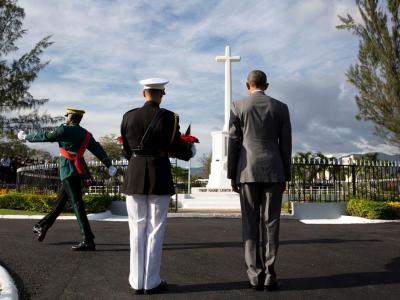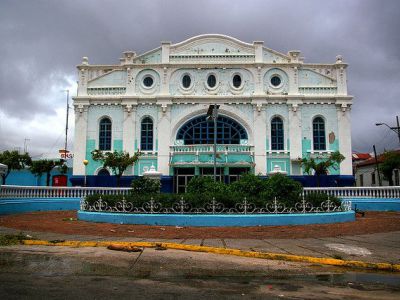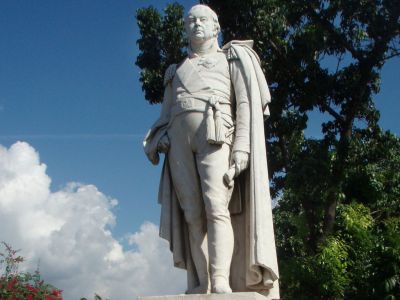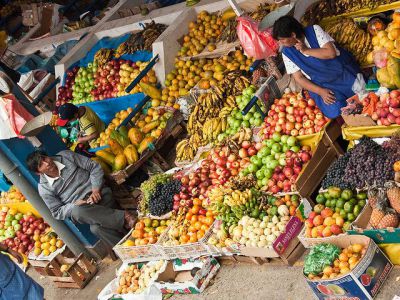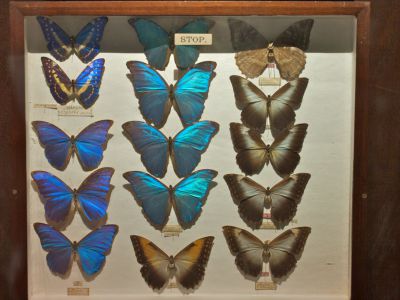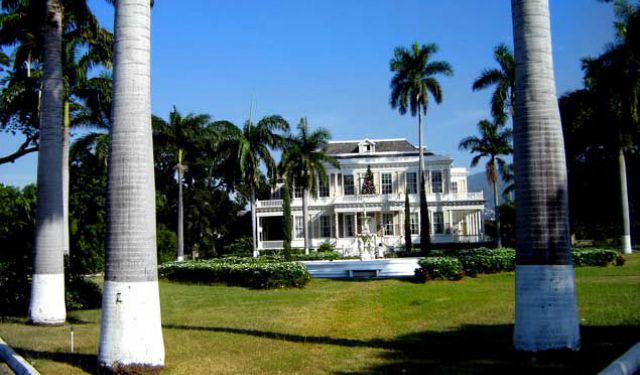
Kingston Introduction Walking Tour (Self Guided), Kingston
They say, "Kingston is the heartbeat of Jamaica, in which the rhythm of life, echoing through the streets, is felt in every step, every beat, and every smile."
Kingston's history dates back to the late 17th century when it was established as a refuge for survivors of an earthquake that destroyed the nearby town of Port Royal. The name "Kingston" was given to the city in honor of King William III of England, who ruled during its founding in 1692, and it signifies the city's historical connection to British colonial rule and the monarchy.
Initially, Kingston served as a small agricultural community, but quickly grew in importance as a trading port for goods such as sugar, rum, and coffee. During the 19th century, Kingston became the commercial and administrative center of Jamaica. It saw significant growth and development with the construction of impressive buildings and infrastructure, including churches, courthouses, and a railway network. However, throughout its history, Kingston also suffered several man-made and natural disasters such as a massive fire in 1882 and a devastating earthquake in 1907.
In the 20th century, Kingston continued to flourish after its independence from the British crown and became a center for cultural and artistic expression, giving birth to various forms of Jamaican music, most notably reggae. Aside from reggae (the country's main attraction), however, the bustling and diverse Jamaican capital boasts a mix of other landmarks of cultural, historical, religious, and architectural importance.
These include National Heroes Park and Saint William Grant Park, commonly known as Parade; the iconic Ward Theater, the oldest theater in the English-speaking Caribbean; the National Gallery of Jamaica, also the oldest and largest public art museum in the English-speaking Caribbean; and more.
The vibrant Coronation Market, the largest open-air market in Jamaica, is a hub of commercial activity, ideal for those seeking to immerse themselves in the local culture.
Undoubtedly, Kingston is a city that embodies the Jamaican spirit, vibrancy, and cultural richness. Any attempt to capture the essence of it on a single trip may prove futile. However, a road of thousand miles starts with a first step, and if you're keen to take it now, you can do it safely by taking this self-guided introductory walk.
Kingston's history dates back to the late 17th century when it was established as a refuge for survivors of an earthquake that destroyed the nearby town of Port Royal. The name "Kingston" was given to the city in honor of King William III of England, who ruled during its founding in 1692, and it signifies the city's historical connection to British colonial rule and the monarchy.
Initially, Kingston served as a small agricultural community, but quickly grew in importance as a trading port for goods such as sugar, rum, and coffee. During the 19th century, Kingston became the commercial and administrative center of Jamaica. It saw significant growth and development with the construction of impressive buildings and infrastructure, including churches, courthouses, and a railway network. However, throughout its history, Kingston also suffered several man-made and natural disasters such as a massive fire in 1882 and a devastating earthquake in 1907.
In the 20th century, Kingston continued to flourish after its independence from the British crown and became a center for cultural and artistic expression, giving birth to various forms of Jamaican music, most notably reggae. Aside from reggae (the country's main attraction), however, the bustling and diverse Jamaican capital boasts a mix of other landmarks of cultural, historical, religious, and architectural importance.
These include National Heroes Park and Saint William Grant Park, commonly known as Parade; the iconic Ward Theater, the oldest theater in the English-speaking Caribbean; the National Gallery of Jamaica, also the oldest and largest public art museum in the English-speaking Caribbean; and more.
The vibrant Coronation Market, the largest open-air market in Jamaica, is a hub of commercial activity, ideal for those seeking to immerse themselves in the local culture.
Undoubtedly, Kingston is a city that embodies the Jamaican spirit, vibrancy, and cultural richness. Any attempt to capture the essence of it on a single trip may prove futile. However, a road of thousand miles starts with a first step, and if you're keen to take it now, you can do it safely by taking this self-guided introductory walk.
How it works: Download the app "GPSmyCity: Walks in 1K+ Cities" from Apple App Store or Google Play Store to your mobile phone or tablet. The app turns your mobile device into a personal tour guide and its built-in GPS navigation functions guide you from one tour stop to next. The app works offline, so no data plan is needed when traveling abroad.
Kingston Introduction Walking Tour Map
Guide Name: Kingston Introduction Walking Tour
Guide Location: Jamaica » Kingston (See other walking tours in Kingston)
Guide Type: Self-guided Walking Tour (Sightseeing)
# of Attractions: 6
Tour Duration: 2 Hour(s)
Travel Distance: 3.8 Km or 2.4 Miles
Author: vickyc
Sight(s) Featured in This Guide:
Guide Location: Jamaica » Kingston (See other walking tours in Kingston)
Guide Type: Self-guided Walking Tour (Sightseeing)
# of Attractions: 6
Tour Duration: 2 Hour(s)
Travel Distance: 3.8 Km or 2.4 Miles
Author: vickyc
Sight(s) Featured in This Guide:
- National Heroes Park
- Ward Theater
- St William Grant Park
- Coronation Market
- National Gallery of Jamaica
- Institute of Jamaica
1) National Heroes Park
National Heroes Park, previously known as King George VI Memorial Park, is a sprawling botanical garden situated in Kingston. Spanning an impressive 50 acres, it stands as the largest open space within the city. This remarkable park houses numerous monuments and serves as the final resting place for many of Jamaica's National Heroes, Prime Ministers, and influential cultural figures.
Originally known as Kingston Race Course, the park was established in 1783 as a one-mile horse racing track. In 1905, it became Knutsford Park and was later transformed into a public park. It was renamed King George VI Memorial Park to honor the king. After Jamaica's independence in 1962, the park acquired its current name.
An outstanding feature within the park is the Jamaica War Memorial, a cenotaph dedicated to the brave Jamaicans who lost their lives during World War I and World War II. Originally erected in 1922 on Church Street in downtown Kingston, it was relocated to its present position in 1953. The memorial, adorned with a substantial cross weighing one and a half tons, holds significant prominence within the park.
A monument for Norman Manley was built on September 16, 1972. It has twelve pillars arranged in two circles, with taller inner pillars. The center holds Manley's tomb, topped with a six-pointed star. Each pair of pillars represents a different aspect of Manley's life, initially with plaques describing these aspects attached.
The Smile Jamaica Concert, featuring the legendary reggae superstars Bob Marley & The Wailers, took place at the National Heroes Park. The initial concert occurred on December 5, 1976, while the second edition was held on February 10, 2007.
Originally known as Kingston Race Course, the park was established in 1783 as a one-mile horse racing track. In 1905, it became Knutsford Park and was later transformed into a public park. It was renamed King George VI Memorial Park to honor the king. After Jamaica's independence in 1962, the park acquired its current name.
An outstanding feature within the park is the Jamaica War Memorial, a cenotaph dedicated to the brave Jamaicans who lost their lives during World War I and World War II. Originally erected in 1922 on Church Street in downtown Kingston, it was relocated to its present position in 1953. The memorial, adorned with a substantial cross weighing one and a half tons, holds significant prominence within the park.
A monument for Norman Manley was built on September 16, 1972. It has twelve pillars arranged in two circles, with taller inner pillars. The center holds Manley's tomb, topped with a six-pointed star. Each pair of pillars represents a different aspect of Manley's life, initially with plaques describing these aspects attached.
The Smile Jamaica Concert, featuring the legendary reggae superstars Bob Marley & The Wailers, took place at the National Heroes Park. The initial concert occurred on December 5, 1976, while the second edition was held on February 10, 2007.
2) Ward Theater
Situated at the heart of Kingston, the Ward Theatre stands as the third theater to grace this very site since 1775. Its inaugural performance took place on December 16, 1912, featuring Gilbert & Sullivan's beloved production, "Pirates of Penzance." The seating arrangements cater to the audience across parquette, dress circle, and gallery levels, while the stage extends a generous 30 feet in depth, accompanied by a dozen dressing rooms.
Starting in 1941, the theater became the cherished venue for annual pantomimes during the Christmas season. Throughout the years, it has welcomed esteemed figures such as Paul Robeson, Charles Laughton, Alicia Markova, Anton Dolin, Arthur Rubinstein, Willard White, and numerous others who graced its stage.
The Ward Theatre, also known as the Grand Theatre for the horror film "Popcorn" (1991), served as a prominent filming location. Virtually every scene was captured either within or outside the theater, immersing viewers in its haunting ambiance.
Recognizing its historical significance, the Ward Theatre was officially declared a National Monument on January 7, 2000. However, the theater suffered substantial damage during the passage of Hurricane Dean in 2007.
In 2012, a dedicated fundraising campaign was initiated to commence the restoration and renovation of the Ward Theatre. Ultimately, it triumphed in its mission, reemerging as a vibrant performing arts venue in 2017.
The stage of the Ward Theatre has witnessed the brilliance of Jamaica's finest theatrical talents and hosted performances by renowned global celebrities. Its profound association with the growth of indigenous theater has carved a special place in the hearts of Jamaicans, solidifying its significance in their cultural heritage.
Starting in 1941, the theater became the cherished venue for annual pantomimes during the Christmas season. Throughout the years, it has welcomed esteemed figures such as Paul Robeson, Charles Laughton, Alicia Markova, Anton Dolin, Arthur Rubinstein, Willard White, and numerous others who graced its stage.
The Ward Theatre, also known as the Grand Theatre for the horror film "Popcorn" (1991), served as a prominent filming location. Virtually every scene was captured either within or outside the theater, immersing viewers in its haunting ambiance.
Recognizing its historical significance, the Ward Theatre was officially declared a National Monument on January 7, 2000. However, the theater suffered substantial damage during the passage of Hurricane Dean in 2007.
In 2012, a dedicated fundraising campaign was initiated to commence the restoration and renovation of the Ward Theatre. Ultimately, it triumphed in its mission, reemerging as a vibrant performing arts venue in 2017.
The stage of the Ward Theatre has witnessed the brilliance of Jamaica's finest theatrical talents and hosted performances by renowned global celebrities. Its profound association with the growth of indigenous theater has carved a special place in the hearts of Jamaicans, solidifying its significance in their cultural heritage.
3) St William Grant Park
St. William Grant Park, located in the heart of Downtown Kingston, is a historically significant public space that pays tribute to important figures in the nation's history. This park, formerly known as Victoria Park, underwent a name change after Jamaica gained independence to honor William Grant, a prominent labor leader from 1938. Grant was closely associated with the Rt. Excellent Sir Alexander Bustamante, who was not only a National Hero but also a former Prime Minister of Jamaica.
St. William Grant Park boasts several notable monuments that contribute to its historical and cultural significance. Among these monuments, the centerpiece is the statue of Queen Victoria, which serves as a reminder of Jamaica's colonial past. The statue stands as a testament to the island's rich heritage and the complex history that has shaped the nation.
To the north of the park stands the statue of Rt. Excellent Norman Manley, a distinguished Jamaican statesman, and National Hero. Norman Manley played a crucial role in the country's struggle for independence and is revered for his contributions to Jamaica's political and social development.
To the south of the park, visitors can find the statue of Rt. Excellent Sir Alexander Bustamante, another National Hero and an influential figure in Jamaica's history. Bustamante was the founder of the Jamaica Labour Party and served as the country's first Prime Minister after independence. His statue stands as a symbol of his leadership and the significant impact he had on the nation.
Whether it's the towering statues or the tranquil surroundings, visitors to St. William Grant Park can immerse themselves in the history and culture of Jamaica while enjoying a peaceful and serene environment in the heart of Kingston.
St. William Grant Park boasts several notable monuments that contribute to its historical and cultural significance. Among these monuments, the centerpiece is the statue of Queen Victoria, which serves as a reminder of Jamaica's colonial past. The statue stands as a testament to the island's rich heritage and the complex history that has shaped the nation.
To the north of the park stands the statue of Rt. Excellent Norman Manley, a distinguished Jamaican statesman, and National Hero. Norman Manley played a crucial role in the country's struggle for independence and is revered for his contributions to Jamaica's political and social development.
To the south of the park, visitors can find the statue of Rt. Excellent Sir Alexander Bustamante, another National Hero and an influential figure in Jamaica's history. Bustamante was the founder of the Jamaica Labour Party and served as the country's first Prime Minister after independence. His statue stands as a symbol of his leadership and the significant impact he had on the nation.
Whether it's the towering statues or the tranquil surroundings, visitors to St. William Grant Park can immerse themselves in the history and culture of Jamaica while enjoying a peaceful and serene environment in the heart of Kingston.
4) Coronation Market
Coronation Market, located in Downtown Kingston, is not just any ordinary market—it is the largest and most vibrant marketplace in Jamaica. Stepping into Coronation Market is like immersing yourself in the pulse of Jamaican life, where the ordinary Jamaican people come together to engage in trade and commerce.
This bustling market serves as a hub for vendors from all corners of the island, who gather here to both wholesale and retail a wide variety of goods. From fresh fruits and vegetables to spices, meats, seafood, and even handicrafts, Coronation Market offers a diverse range of products to satisfy the needs of its customers. One of the market's unique features is its reputation for selling goods at significantly lower prices compared to other establishments, making it an attractive destination for bargain hunters.
Coronation Market, often affectionately referred to as 'Curry' by the locals, exudes an energy and liveliness that is unmatched. As you navigate through the market, you will witness men skillfully pushing around laden carts, maneuvering their way through the narrow aisles. The vendors, stationed in small and tightly packed stalls, engage in lively negotiations with customers, proudly showcasing their fresh produce and wares.
Fridays and Saturdays are the busiest days at Coronation Market. During these times, it feels as though half the country has descended upon the market, all seeking to secure their share of the freshest produce at competitive prices. The vibrant atmosphere, the cacophony of voices, and the rich aromas of the various foods being cooked create an immersive experience that truly captures the essence of Jamaica's unique culture.
This bustling market serves as a hub for vendors from all corners of the island, who gather here to both wholesale and retail a wide variety of goods. From fresh fruits and vegetables to spices, meats, seafood, and even handicrafts, Coronation Market offers a diverse range of products to satisfy the needs of its customers. One of the market's unique features is its reputation for selling goods at significantly lower prices compared to other establishments, making it an attractive destination for bargain hunters.
Coronation Market, often affectionately referred to as 'Curry' by the locals, exudes an energy and liveliness that is unmatched. As you navigate through the market, you will witness men skillfully pushing around laden carts, maneuvering their way through the narrow aisles. The vendors, stationed in small and tightly packed stalls, engage in lively negotiations with customers, proudly showcasing their fresh produce and wares.
Fridays and Saturdays are the busiest days at Coronation Market. During these times, it feels as though half the country has descended upon the market, all seeking to secure their share of the freshest produce at competitive prices. The vibrant atmosphere, the cacophony of voices, and the rich aromas of the various foods being cooked create an immersive experience that truly captures the essence of Jamaica's unique culture.
5) National Gallery of Jamaica
Situated in Kingston, the National Gallery of Jamaica stands as the nation's esteemed public art museum. Since its establishment in 1974, the gallery has found its home within the bustling Kingston Mall—a vibrant hub of commerce and culture nestled along the shores of Kingston Harbor. Complementing its main location, the National Gallery of Jamaica extends its reach to Montego Bay with the presence of the National Gallery West.
Within its walls, the gallery proudly showcases a multitude of significant works primarily created by Jamaican artists. Renowned visionaries such as John Dunkley, Mallica "Kapo" Reynolds, Edna Manley, Barrington Watson, Albert Artwell, Everald Brown, Cecil Baugh, Albert Huie, Carl Abrahams, Osmond Watson, Judy Ann MacMillan, Omari Ra, Laura Facey, Jasmine Thomas-Girvan, Petrona Morrison, Hope Brooks, Ebony G. Patterson, Philip Thomas, and Leasho Johnson contribute to the rich tapestry of artistic expression exhibited here.
While celebrating Jamaica's artistic heritage, the National Gallery also embraces the global artistic community by featuring works from diverse international artists and hosting traveling exhibitions. Moreover, it serves as a valuable resource center for research material on Jamaican art and culture, while simultaneously coordinating educational programs that foster an appreciation for the arts.
Within its walls, the gallery proudly showcases a multitude of significant works primarily created by Jamaican artists. Renowned visionaries such as John Dunkley, Mallica "Kapo" Reynolds, Edna Manley, Barrington Watson, Albert Artwell, Everald Brown, Cecil Baugh, Albert Huie, Carl Abrahams, Osmond Watson, Judy Ann MacMillan, Omari Ra, Laura Facey, Jasmine Thomas-Girvan, Petrona Morrison, Hope Brooks, Ebony G. Patterson, Philip Thomas, and Leasho Johnson contribute to the rich tapestry of artistic expression exhibited here.
While celebrating Jamaica's artistic heritage, the National Gallery also embraces the global artistic community by featuring works from diverse international artists and hosting traveling exhibitions. Moreover, it serves as a valuable resource center for research material on Jamaican art and culture, while simultaneously coordinating educational programs that foster an appreciation for the arts.
6) Institute of Jamaica
Founded in 1879, the Institute of Jamaica stands as Jamaica's most influential organization dedicated to culture, art, and science. It assumes the role of a patron and advocates for the arts in Jamaica, supporting exhibitions and granting awards. Moreover, the Institute serves as the governing body for the nation's museums while overseeing various national artistic and cultural institutions, including the National Gallery, the African Caribbean Institute of Jamaica, and the Jamaica Journal.
Sir Anthony Musgrave, then Governor of Jamaica, established the Institute of Jamaica to foster literature, science, and art on the island in 1879. As such, its mission is centered on assisting the government in promoting and safeguarding the country's rich cultural heritage. Undoubtedly, it remains Jamaica's preeminent organization for culture, art, and science.
The Institute's operations encompass a range of responsibilities within each division. These responsibilities include establishing and managing museums and galleries to collect, preserve, and showcase artifacts and artistic treasures (National Museum Jamaica); curating and displaying collections of Jamaica's flora and fauna (Natural History); nurturing the artistic potential of children in visual and performing arts while fostering their appreciation for Jamaican culture (Junior Centres); and acquiring Jamaican artwork for public exhibition (National Gallery).
Sir Anthony Musgrave, then Governor of Jamaica, established the Institute of Jamaica to foster literature, science, and art on the island in 1879. As such, its mission is centered on assisting the government in promoting and safeguarding the country's rich cultural heritage. Undoubtedly, it remains Jamaica's preeminent organization for culture, art, and science.
The Institute's operations encompass a range of responsibilities within each division. These responsibilities include establishing and managing museums and galleries to collect, preserve, and showcase artifacts and artistic treasures (National Museum Jamaica); curating and displaying collections of Jamaica's flora and fauna (Natural History); nurturing the artistic potential of children in visual and performing arts while fostering their appreciation for Jamaican culture (Junior Centres); and acquiring Jamaican artwork for public exhibition (National Gallery).
Walking Tours in Kingston, Jamaica
Create Your Own Walk in Kingston
Creating your own self-guided walk in Kingston is easy and fun. Choose the city attractions that you want to see and a walk route map will be created just for you. You can even set your hotel as the start point of the walk.
Saint Andrew Parish Walking Tour
Saint Andrew (also known by its Creole equivalent as Sint Anju) is a parish that surrounds Kingston to the north, west, and east, extending into the scenic Blue Mountains. Renowned as the birthplace of one of Jamaica's national heroes George William Gordon, this part of the capital is also home to various attractions, historical landmarks, and notable residents (both, past and present).... view more
Tour Duration: 2 Hour(s)
Travel Distance: 4.6 Km or 2.9 Miles
Tour Duration: 2 Hour(s)
Travel Distance: 4.6 Km or 2.9 Miles
The Most Popular Cities
/ view all
